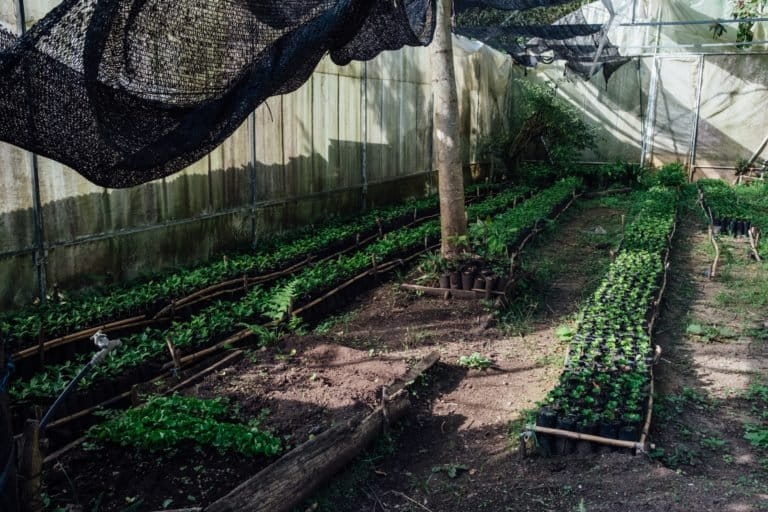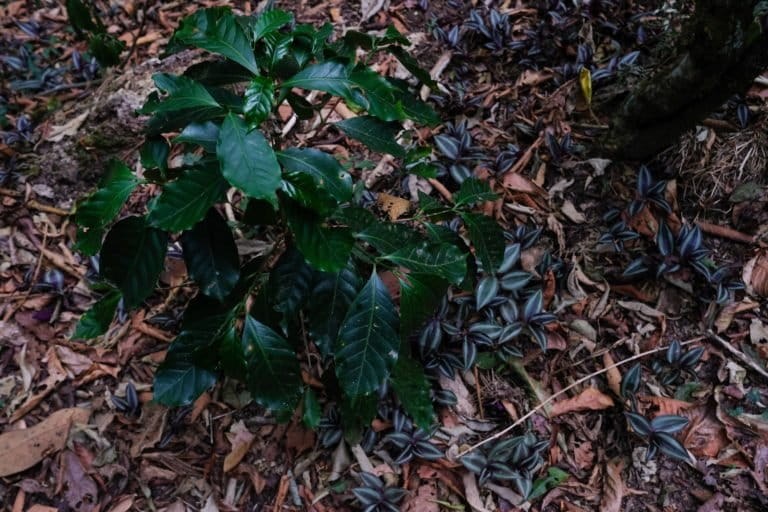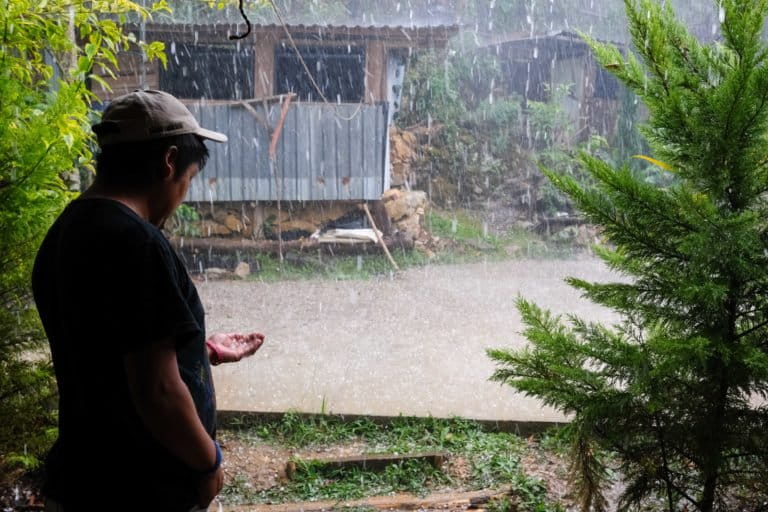- Indigenous Mixe farmers in Mexico’s Sierra Norte highlands are testing dozens of coffee varieties and developing agroforestry systems in order to combat coffee leaf rust, a fungal disease that spread to the region and devastated coffee production.
- The parasitic fungus thrives in wet and warm temperatures, say researchers, which are becoming more frequent in Mexico’s highlands amid changes in climate.
- The project tests the resistance of over 27 different varieties of coffee within a shaded agroforestry system that helps decrease temperatures and create drier conditions – reducing the fungi’s spread.
- Cultivating organic coffee in times of unpredictable weather is risky, costly and a laborious exercise. The cost of production is also growing, affecting farmers’ eagerness and capacity to cultivate.
SANTIAGO ATITLÁN, Mexico – Lucio Jimenez Ocampo is always surrounded by coffee. In the yard of his house in Santiago Atitlán nestled in the Oaxaca state’s Sierra Norte highlands, there are about a hundred organic coffee plants of different varieties packaged in plastic bags. On his terrace, coffee beans of the Geisha variety are waiting to be sold to other farmers.
The plants are part of an Oaxacan farmers’ project testing coffee varieties and developing agroforestry plantations resistant to a fungal disease, known as coffee leaf rust, that ravaged coffee crops seven years ago. Coffee rust has no cure. But Lucio and other Indigenous Mixe farmers hope the project will protect the majority of their coffee production from the spreading fungus as it climbs further up mountains and reproduces under wetter and warming temperatures.

When coffee rust came to Atitlán in 2015, farmers were not prepared. When the parasitic fungi Hemileia vastatrix comes into contact with a coffee plant, it latches on and covers its leaves with orange spots. This ultimately reduces the plants’ ability to conduct photosynthesis. As leaves fall, less coffee cherries and seeds are produced. The seeds (known as coffee beans) inside the cherries are shrunken – affecting the quality and value of the coffee.
The state of Oaxaca lost about 50% of its production volume that year. Farmers in Atitlán say the production decline was higher, at about 80%. Coffee rust is still present in the region. Many coffee producers left the village and their crops in search for work in other Mexican states or in the U.S.
“Coffee was the only source of income for our family, the only crop that maintains our livelihood,” says Leon Castañeda Rojas, a coffee farmer in Santiago Atitlán. “And then the rust destroyed all our plants.”
Coffee rust is becoming frequent, and climate change could be the main contributor, says a study published in Science of the Total Environment.

With the slightest increase in temperature or rainfall, the fungus thrives, says Dr. Elda Melchor-Martínez, one of the authors of the study. New generations are born, and it climbs to higher warming altitudes where Arabica coffee (Coffea arabica), the most popularly produced species in Mexico, typically grows.
Coffee leaf rust first appeared in Brazil in the 1970s and spread throughout Latin American coffee farms. In Colombia, coffee farmers reported a loss of about one-third of their production in 2008. In Central America, the fungus destroyed 10 to 55% of all Arabica coffee crops between 2012 and 2016.
For residents in Sierra Norte highlands, Mexico’s warming temperatures are to blame for the 2015 outbreak in Atitlán. In the past 40 years, temperatures have increased by about 1.4 degrees Celsius in the country, according to the National Meteorological Service.

“We had observed changes in climate. It was becoming very hot and the rains were very strong,” Lucio recalls. “It rained in April and May when it was the dry season. People from outside warned us to prepare ourselves for the coffee rust but we did not listen.”
According to Mexico’s 2019 Operation Rules of the Agriculture Promotion Program, small coffee producers face the great challenge of losing their coffee production due to the coffee rust and other devastating fungi, such as, Mycena citricolor. Worryingly, the coffee sector is not taken into consideration in national climate policies, says Dr. José Luis Jaramillo Villanueva, a professor of rural development at Colegio de Postgraduados in Puebla.
However, a state-wide coffee farmers’ project in Oaxaca is trying to help farmers face the challenges. Coffee leaf rust has no cure, but farmers hope this project can reduce its impact.

Producing resistant, organic coffee
After the 2015 disaster, a non-profit organization, State Coordinator of Coffee Producers in Oaxaca (CEPCO) came to farmers in Atitlán with a plan; to cut down all their old coffee plants and plant new organic ones. They wanted to bring coffee plants back to a traditional shaded agroforestry ecosystem, research which varieties are resistant and see whether they can reduce the propensity of coffee rust.
“A lot of people were [either] against it or it was very hard to persuade them, especially the older producers,” says Ana Tejero Aranda, who works as a coordinator of environmental issues at CEPCO. “We analyzed the issues and solutions and then we organized meetings with each cooperative (united in CEPCO) where we tried to motivate producers to restructure their coffee fields. After that, we just kept on insisting.”
Over time, they eventually agreed. Farmers in Atitlán are part of more than 3,300 coffee producers forming CEPCO’s regional 46 cooperatives.

Lucio, a member of Atitlán’s cooperative, Defensa de la Ecología Atitlán, planted his first new coffee plants in 2016 and waited three years for his crops to produce cherries and beans ready to be sold. In 2021, he sold a harvest of almost 290 kilograms (639 pounds) of coffee beans collected from 2,000 plants.
Today, walking through Lucio’s coffee plantation is like exploring an enchanting forest of lush vegetation, fruit trees and leafy coffee plants. The purple leaves and stems of creeping inch plants (Tradescantia zebrina) weave in between some of the crops.
“These plants give nitrogen to the soil,” Lucio explains. The quality and fertility of the soil was poor when the coffee rust arrived, which removed a layer of defense from the coffee plants.
“Coffee producers were focusing on plants too much. We switched their focus to the soil. It could be revitalized with its own microorganisms or using compost. Even though many of the practices were already in place, we encouraged them even more,” says Tejero.

To increase soil nutrition and protect plants from erosion during heavy rains, coffee producers create ‘vivid barriers’ and ‘dead barriers.’ Piles of dry branches lie underneath coffee plants to protect the plant from the spreading fungus, forming dead barriers. Distributed between Lucio’s coffee plants in rows are cinnamon and lime trees along with avocados, forming vivid barriers.
“This is a ‘father tree’ for coffee plants,” Lucio points at the tree that covers the whole coffee plant with its crown. He names it chalahuite and adds that this tree provides not only shade but also nutrition for the plant.
The trees provide shade, which has been key in protecting plants from coffee rust by reducing temperatures and creating drier conditions to prevent the fungus from reproducing.
“We are also focusing on diversification in trees that can provide the best shade while regenerating landscapes,” Tejero Aranda explains.

CEPCO is cooperating with Livelihoods Funds to increase the quantity and diversity of shade and fruit trees to provide coffee producers with further income. For example, Lucio has planted white cedars and plans to sell its wood in twenty years.
Although the project called for an overhaul in the coffee plants used, Atitlán coffee farmers are wary and only cut down old plants and replace them with new varieties section by section. They plant different varieties in a plot and observe which ones are more resistant to coffee rust. Different varieties are planted nearby one another to see how they react to coffee rust once they are again exposed.
“We receive many different varieties, pick specific lands and plant them there to see how they adapt,” Ana Tejero Aranda explains. The seeds of successful varieties are then sold to other farmers.
The way certain varieties of coffee resist is observed under the supervision of technicians who are present when farmers need any advice on how to grow their crops. Some of the newly planted coffee plants have lost their leaves to coffee rust.

“Technical support is also one of the things that coffee producers in Oaxaca lack the most,” says Jaramillo Villanueva. “The government provides technical assistance but only to about two percent of all producers. The problem is that even with the greatest political will, there is just not enough experienced people and this education takes years.”
CEPCO is cooperating with the government to provide such educational support to farmers in Atitlán and across Oaxaca. Lucio recently became a community technician of CEPCO and advises other coffee producers in how to grow their coffee – from how to prepare new seedlings and regenerate the plantation, to taking care of crops and observing which varieties are resistant to the rust.
Oro Azteca, a native variety to Mexico, shows very little resistance to the coffee rust. It again lost its leaves to coffee rust five years after the first 2015 outbreak. The Typica and Bourbon varieties are also not resistant but are popular in the coffee market and in demand due to their taste. Lucio still grows them even though they need a lot of care, but he does not recommend farmers grow only one variety.
“Even if the coffee rust is under control for now, it is here to stay and we have to learn to live with it,” Lucio argues.

On his land, he plants varieties such as Costa Rica, Sarchimor, and Geisha. While the first two are the most resistant in his plantations and bring more beans for less investment, Lucio gets about $1 more per kilogram of Geisha sold – a big difference for a local coffee farmer. He plans to soon have as much as 27 different varieties of coffee in one of his plots to test their resistance.
Cultivating organic coffee in times of unpredictable weather is risky, costly and a laborious exercise. Trying to get a fair price in a market when the cost of production is only growing affects Oaxacan farmers’ eagerness and capacity to keep on growing coffee.
“Cleaning the plantations is expensive and needs to be done at least twice a year,” says Adelina Castañeda Martinez from the cooperative La Puerta del Rey Condoy in San Isidro Huayápam, an hour away from Atitlán. “I was not able to harvest all the beans these past few months because I could not afford to pay the workers. We also have a hard time finding workers due to migration out of the region.”
The coffee varieties that are more resistant to the coffee rust are not always the ones that the market demands. Lucio took his chance in his own hands. He believes that some of the high-resistant coffee varieties can be made into a high-quality cup of coffee that the market would be interested in buying at a higher price.

“I am now trying to increase the quality by changing how I process the beans,” he says.
Jaramillo Villanueva of Colegio de Postgraduados in Puebla agrees. If farmers want to be able to cover the costs of preventing coffee rust from proliferating in the region, he says, they cannot sell the cheapest beans. Farmers should put the beans through a hulling process to remove the beans’ outer ‘parchment’ layer.
While individual farmers might not have funding to invest in coffee processing machines, cooperatives could share the expenses and benefits of processing coffee, Jaramillo Villanueva thinks.
Organization in cooperatives like CEPCO brings further education as well as opportunities to sell the coffee for a set price regardless of the market price, Lucio shares.
As Lucio stops near his worm compost, rain starts to fall in the middle of April. Typically, this is the hottest month in Oaxaca and the first rains usually come later in June.
The farmer watches the unexpected rainfall in the heat, knowing these are ideal conditions for the fungus to spread. In two hours, hail falls four times. He stands underneath a metal roof drinking a cup of coffee, wondering what the fate of his crops will be this season.

Banner image: One of the Indigenous farmers walking amid her coffee plantation. Image courtesy of Noel Rojo.
Related listening from Mongabay podcast: We look at how agroforestry, an ancient indigenous technology that is increasingly being adopted by farmers around the world, can help solve many of the major environmental issues we’re facing, from deforestation and biodiversity loss to climate change. Listen here:
FEEDBACK: Use this form to send a message to the author of this post. If you want to post a public comment, you can do that at the bottom of the page.